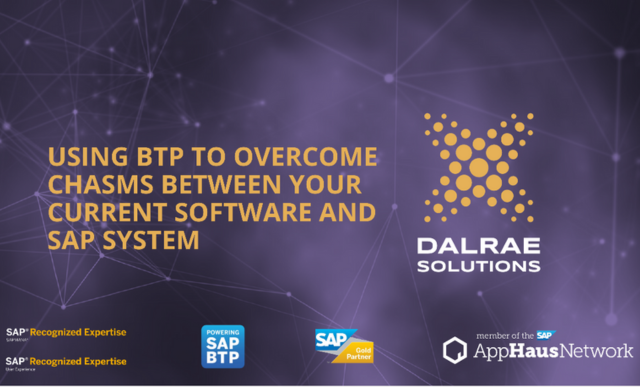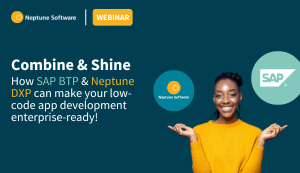Enable Business Outcomes with Enriched Data
By Fred Donovan, Senior Editor, SAPinsider
Organizations want to better understand and leverage the data they have. Unfortunately, they often do not know how much cloud elasticity they will need to get the most out of that data. And they usually do not want to put additional systems in place that add more complexity to their landscape. According to SAPinsider’s SAP Integration Landscape Benchmark Report, the complexity of customers’ SAP landscapes is growing: A majority of respondents said they were integrating an average of 11 business solutions with their enterprise resource planning (ERP) system and were using an average of four integration tools to perform these integrations. Around 90% of respondents said that they needed to support non-SAP to SAP integration scenarios, and fewer than 10% of respondents said that their current integration strategy is completely meeting their needs.
SAPinsider interviewed Edy Sardilli, Global Alliances and Strategic Business Development Leader at Google Cloud, and Alison Hettrick, Head of SAP Solution Management at Google Cloud, to better understand this challenge and how Google Cloud is addressing it.
Many organizations are struggling to enrich and process their data to gain business insights for better decision-making, Sardilli says. To give SAP customers tools to integrate their systems with non-SAP systems and to better consume and enrich their data, Google Cloud is launching Google Cloud Cortex Framework. This framework will offer scenario-driven reference architectures, analytic templates, sample deployment content, accelerators, and integration services.
“The challenges with data are tremendous. You don’t want a customer dealing with data integration services and data wrangling daily. If you can arrange that data for them, that becomes super helpful. In addition, our customers ask, can you deliver content accelerators and actual outcomes for my business so that I don’t have to build it and iterate it myself?” Sardilli says.
Sardilli adds that by using Google Cloud Cortex Framework, companies have much less to worry about with regards to how the target data model and data extraction happens — they only need to adjust the model to make sure the business serves customers or partners effectively.
“When customers want to extend the content and create a new data view, or use case, they should be able to do that without having to worry about the inner complexities of a data warehouse,” he says.
Hettrick adds that Google Cloud Cortex Framework will provide “ready-to-run, pre-delivered data management code and views that leverage BigQuery, which customers can easily install and deploy. We’ll also include sample datasets and reporting templates in Looker to help them get started.”
She says that Google Cloud Cortex Framework will enable the delivery of business outcomes using enriched data from SAP and other data sources such as Google trends, weather, and syndicated data sets. SAP customers will be able to deploy data solutions faster, take advantage of data management best practices, and achieve business outcomes more quickly.
“Instead of something taking weeks or months to deploy, we can help customers understand the right technologies and solutions that should be included in the data and analytics reference architecture,” she says.
“For example, Google Cloud Cortex Framework offers pre-built data marts for customers for common operational reporting and analytics scenarios in sales and distribution, including order management and fulfillment, so that they do not have to start from scratch. And that translates into a lot of savings and benefits in terms of the knowledge, know-how, and time and effort to implement,” she adds.
The goal of Google Cloud Cortex Framework is to take the guesswork out of how to assemble and combine the technologies of Google along with the SAP ecosystem to accelerate business value and incorporate ready-to-run accelerators so SAP customers can become more efficient and nimble, Hettrick says.
Google Cloud Cortex Framework Scenarios
Google Cloud Cortex Framework scenarios provide SAP customers with architecture patterns, sample deployment content, partner-provided integration services, as well as deployment templates and training content.
The scenarios are based on a set of standardized raw data source tables and views that support a data foundation in BigQuery for SAP as well as broader enterprise, community, and public data sets. On top of that, Hettrick says, Google Cloud is building and deploying a set of sample Looker blocks to accelerate delivery of reporting. Sardilli relates: “Our customers are asking us, what’s the best technology to do change data capture, for example, from SAP tables to BigQuery? It becomes an overwhelming decision-making process for them. They’re asking us, can you please tell me what the recommended best approach is? Can you evaluate the different technology and technology partners and guide us with SAP and non-SAP data going forward?”
“We’re delivering our first release of Google Cloud Cortex Framework set of data mart accelerator content for customers looking to take advantage of our petabyte-scale cloud data warehouse, BigQuery. We’re delivering more than 40 modeling views that handle a lot of the key areas of interest such as sales and distribution with SAP data,” Hettrick says.
“There will be additional views that extend the value of SAP data with other data sets such as weather, Google Search trends, and other kinds of information. We’re also delivering demand impact alerts leveraging our artificial intelligence and machine learning capabilities that focus on how we can provide additional demand signals that might otherwise not be considered and can help organizations to better shape demand,” Hettrick adds. The scenarios are delivered as packaged solutions that include technologies from Google Cloud, SAP, independent software vendors, and system integrator partners to reduce overall time, complexity, and costs.
“The Cortex Framework allows our customers to adapt content quickly and build new scenarios across lines of business such as supply chain, and industries such as consumer packaged goods, retail, and manufacturing. We’re putting together a reference architecture to help integrate with the SAP ecosystem,” Sardilli says.
Google Cloud Cortex Framework Use Cases
Sardilli says that customers are also seeking help to stand up use cases and are looking for a partner to deliver content, accelerators, and outcomes for their business, so they don’t have to build it and iterate it themselves.
“You can think of Google Cloud Cortex Framework as a set of building blocks and blueprints by which we can provide knowledge, expertise, and best practices on how to assemble the technologies from Google Cloud, SAP, and our partners to help our customers accelerate capabilities,” Hettrick relates.
“Our initial focus will be around the SAP Business Suite, specifically SAP ERP Central Component (ECC) and SAP S/4HANA customers. Our goal is to work with data at the transactional level and be able to combine that with some of the additional data sets that Google Cloud is providing and delivering,” she says.
One of the first areas that Google Cloud Cortex Framework will be available for SAP customers is consumer-focused scenarios.
“SAP customers can integrate SAP data quickly with Google Cloud data signals, trends, ads, and commerce information. By integrating this information and providing advanced machine learning and insights around this data, they will be able to do more dynamic things in today’s world, especially around supply chain and commerce,” Sardilli says.
“We want to take SAP operational data and integrate it with commerce data and other data to make sure that we’re getting a good 360-degree view of what’s happening with the consumer in the channel,” he adds.
Hettrick says that by using Google Cloud Cortex Framework, customers can realize business benefits and establish an incremental approach to continuous delivery of innovation to their business.
“Google Cloud Cortex Framework incorporates SAP technologies and can leverage SAP components along with Google Cloud components to connect SAP and non-SAP systems,” explains Sardilli.
Hettrick adds, “For customers that want more expansive access to larger data sets, contextual data, and related information, we look at Google Cloud Cortex Framework as a combined reference architecture to take advantage of the best of Google’s and SAP’s technologies.”
“Google Cloud recognizes the importance of heterogeneity, flexibility, and openness, and that’s part of our core guiding principles. And most importantly, we focus on the customer first — what’s important for our customers to be successful,” she says.
Hettrick says that with Google Cloud Cortex Framework customers tell her they see efficiencies in time, effort, and cost. They also are excited for additional scenarios beyond the baseline framework that is planned for release.
“From a reporting and analytics perspective, customers will have ready-to-run content that will range from order fulfillment, customer snapshots, to inventory and other topics. We are also providing a demand-shaping scenario, which focuses on how we can provide demand signals that might not be considered otherwise for more complete demand forecasting,” she says.
SAP Customers Moving to the Cloud
Sardilli says that all SAP customers can benefit from Google Cloud Cortex Framework, regardless of where their SAP environment resides — on-premise or in the cloud. According to SAPinsider’s research report Enterprise Cloud Deployment: State of the Market Benchmark Report, more SAP customers are running analytics, data warehousing and storage, and human resources in the cloud. The report surveyed 116 members of the SAPinsider community and found that almost all the respondents are running some solutions in the cloud and that they want to gain increased flexibility and scalability by moving to the cloud.
The main drivers of the move to the cloud were a business focus on digital transformation and pressure to modernize costs and simplify IT infrastructure. The top four Software-as-a-Service (SaaS) applications that respondents reported they are running included SAP ERP solutions (like SAP S/4HANA Cloud), SAP finance and procurement solutions (like SAP Concur), SAP human resources solutions (like SAP SuccessFactors), and SAP Analytics Cloud.
Google Cloud Cortex Framework can integrate SAP data with Google data and third-party data and enable SAP customers to leverage the cloud and machine learning to gain business insights from the data.
“What cloud brings to the table is you can integrate and build these data pipelines better, and you can manage these data resources without having to manage them, in other words, a serverless architecture. So, you can bring data together and not worry about how it computes and how it gets stored. In addition, the cloud gives elasticity and scale to carry out these data analytics use cases,” Sardilli explains. Customers running SAP on any public or private cloud or on-premise can connect and integrate with Google Cloud Cortex Framework and leverage the platform capabilities and ready-to-run scenarios delivered via Google Cloud’s strategic partner ecosystem, he concludes.
What Does This Mean for SAPinsiders
- As SAPinsider research shows, more SAP customers are running analytics, data warehousing and storage, and human resources in the cloud. Google Cloud Cortex Framework can help you leverage your cloud capabilities for data storage and analytics.
- Employing advanced data analytics can create business value and improved decision-making. Organizations can lower platform costs, improve data query and reporting capabilities, and increase operational efficiencies using data analytics. Using a tool like BigQuery can help organizations integrate, aggregate, and analyze big data from SAP enterprise applications.
- Consider using pre-packaged solutions, such as RISE with SAP and Google Cloud Cortex Framework, to aid in the move to the cloud, particularly if you are a small or medium-sized enterprise that does not have the IT resources to carry out the move using internal resources. These solutions can save you time and money and significantly reduce the complexity of cloud migration and delivery of industry-leading analytics and operational reporting.








